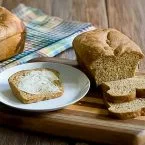Description
This is a delicious and nutritious loaf made with softened cracked wheat, molasses, honey, and sesame seeds. It has a lovely chewy texture and slightly sweet flavor, just perfect for sandwiches or toasting.
Ingredients
Instructions
Step 1: Prepare Cracked Wheat
- Place cracked wheat (or bulgur) in a bowl and pour boiling water over it.
- Let soak for about 1 hour until softened.
Step 2: Activate Yeast
- In a small bowl, mix the yeast with warm water and a pinch of sugar.
- Allow to sit for 7-10 minutes until bubbly and frothy (proofed).
Step 3: Mix Wet Ingredients
- Combine warm buttermilk, molasses, honey, and room-temperature butter in a separate bowl. Mix well to incorporate.
Step 4: Mix Dough
- In a large bowl (or stand mixer bowl fitted with a paddle attachment), mix whole wheat flour, salt, and sesame seeds.
- Add the proofed yeast and the buttermilk mixture, mixing until smooth (approximately 3 minutes).
- Drain cracked wheat thoroughly and mix into the dough.
- Gradually add all-purpose flour, ½ cup at a time, until the dough forms a ball and pulls away from the sides of the bowl.
Step 5: Knead Dough
- If using a stand mixer, switch to a dough hook and knead for 4-5 minutes until dough is soft and springy.
- If kneading by hand, place dough onto a floured surface, knead gently for about 5 minutes, adding minimal flour as needed to avoid sticking.
Step 6: First Rise
- Place dough into a lightly oiled bowl, turning to coat.
- Cover with plastic wrap or a damp kitchen towel.
- Allow to rise in a warm spot for approximately 1½ hours or until doubled in size.
Step 7: Shape and Second Rise
- Gently deflate dough and divide into two loaf pans or three round loaves.
- Place on greased loaf pans or parchment-lined baking sheets.
- Brush tops with melted butter, cover loosely, and let rise again for about 30 minutes.
Step 8: Bake Bread
Preheat oven to 350°F (175°C).
Bake bread for 35-40 minutes until golden brown and hollow-sounding when tapped.
Cool on wire racks before slicing.
Notes
Yeast Activation: Ensure the water temperature is accurate (105-115°F) for proper yeast activation.
Dough Texture: Dough should be soft, springy, and slightly tacky, not sticky.
Avoid Over-Rising: Too long rising time can cause bread to collapse during baking.
- Prep Time: 2 hours 30 mins
- Cook Time: 40 mins
- Category: Bread
- Method: Baking
- Cuisine: American
Nutrition
- Serving Size: 1 slice
- Calories: 160
- Sugar: 5g
- Sodium: 220mg
- Fat: 4g
- Saturated Fat: 2g
- Unsaturated Fat: 2g
- Trans Fat: 0g
- Carbohydrates: 28g
- Fiber: 3g
- Protein: 4g
- Cholesterol: 10mg
